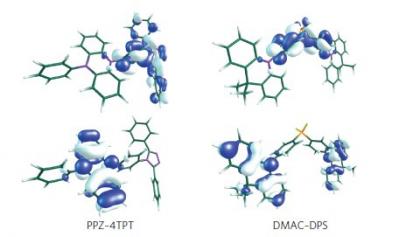TADF are getting a lot of attention now, as a promising new emitter type that could finally enable efficient blue emission, and also efficient alternative to red and green phosphorescent emitters.

Several new TADF research papers have been announced by SID and will be presented at DisplayWeek 2017. Below you will find a list of these recent achievements, at no particular order.
Kyulux and Fukuoka University in Japan developed a new family of blue TADF emitters, based on a donor-acceptor architecture. The new materials achieved high external quantum efficiencies over 19.2% with CIE coordinates of (0.148, 0.098). Kyulux aims to commercialize yellow and green emitters first, but blue is certainly also a target for the TADF startup.
The National Taiwan University are working on acridine-triazine hybrid TADF materials, and managed to fabricate an emitter that exhibits nearly 100% photoluminescence quantum yield, excellent thermal stability, and a horizontal dipole ratio of 83%, leading to extremely efficient blue OLED with external quantum efficiency (EQE) of ~37%.
Cynora will update its latest TADF blue emitter performance. Cynora's material performance was detailed in October 2016, but at SID the company will disclose its latest materials. Earlier this month we posted an interview with Cynora's CMO.
Researchers from Korea's Kyung Hee University have synthesized TADF emitters that show small singlet-triplet energy splitting, high photoluminescence quantum yields, and proper charge-transfer characteristics, resulting in short delayed fluorescence exciton lifetime. The fabricated OLEDs with such green and deep-blue TADF emitters display maximum external quantum efficiency of 31.4% and 22.5%, respectively, with significantly low efficiency roll-off characteristics.
Finally, researchers from Yamagata University in Japan developed and investigated a series of pyrimidine-based pure blue-to-green emitters. A pure blue emitter realized a power efficiency of 20 lm/W at CIE coordinates of (0.16, 0.15), and a green emitter exhibited a power efficiency of over 110 lm/W at CIE coordinates of (0.36, 0.58).

